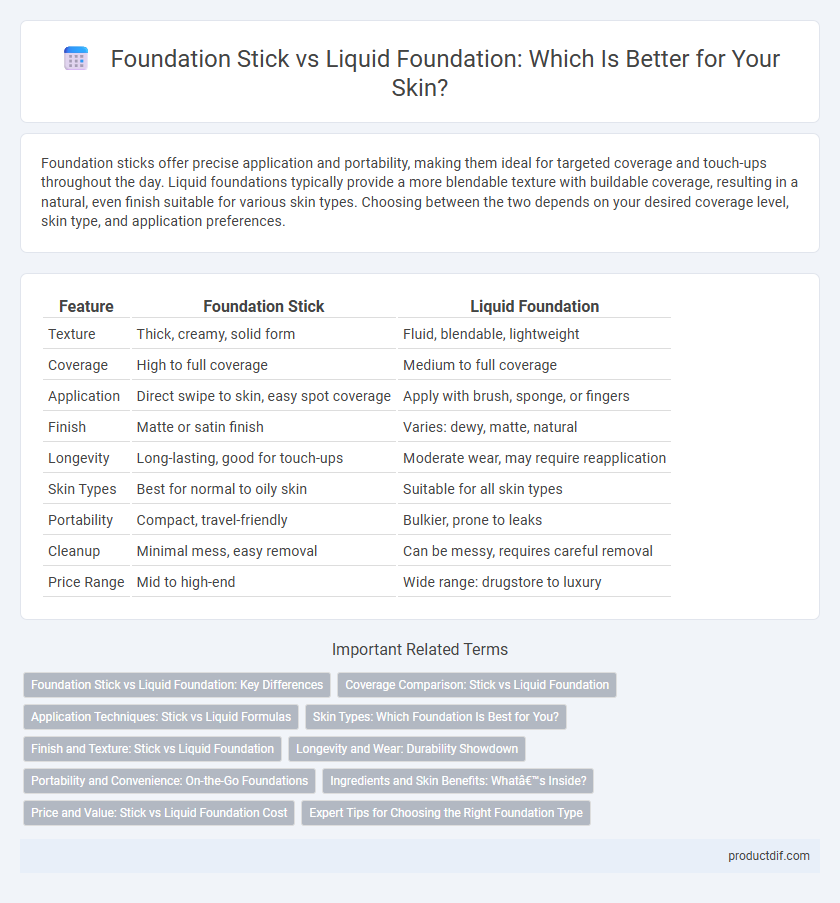Foundation sticks offer precise application and portability, making them ideal for targeted coverage and touch-ups throughout the day. Liquid foundations typically provide a more blendable texture with buildable coverage, resulting in a natural, even finish suitable for various skin types. Choosing between the two depends on your desired coverage level, skin type, and application preferences.
Table of Comparison
| Feature | Foundation Stick | Liquid Foundation |
|---|---|---|
| Texture | Thick, creamy, solid form | Fluid, blendable, lightweight |
| Coverage | High to full coverage | Medium to full coverage |
| Application | Direct swipe to skin, easy spot coverage | Apply with brush, sponge, or fingers |
| Finish | Matte or satin finish | Varies: dewy, matte, natural |
| Longevity | Long-lasting, good for touch-ups | Moderate wear, may require reapplication |
| Skin Types | Best for normal to oily skin | Suitable for all skin types |
| Portability | Compact, travel-friendly | Bulkier, prone to leaks |
| Cleanup | Minimal mess, easy removal | Can be messy, requires careful removal |
| Price Range | Mid to high-end | Wide range: drugstore to luxury |
Foundation Stick vs Liquid Foundation: Key Differences
Foundation sticks offer a creamy, solid formula ideal for precise application and portability, while liquid foundations provide a wider variety of finishes and are better suited for blending over larger areas. Foundation sticks are typically more buildable, allowing targeted coverage for blemishes and contouring, whereas liquid foundations often deliver a smoother, more natural appearance for overall complexion. Both types cater to different skin types and preferences, with foundation sticks favored for dry to normal skin and liquid foundations preferred for oily or combination skin due to their varying hydration levels.
Coverage Comparison: Stick vs Liquid Foundation
Foundation sticks provide a buildable coverage that is ideal for targeted application and touch-ups, offering a thicker, creamier texture that conceals blemishes and uneven skin tone effectively. Liquid foundations tend to deliver a more even, natural finish with variable coverage levels, ranging from sheer to full, suitable for all skin types and customizable with blending tools. The choice between stick and liquid foundation coverage depends on desired finish, skin type, and application preferences.
Application Techniques: Stick vs Liquid Formulas
Foundation sticks offer precise, targeted application, making them ideal for contouring and quick touch-ups with a creamy texture that blends seamlessly using fingers or a sponge. Liquid foundations provide even coverage for larger areas with buildable consistency, best applied with brushes or beauty blenders for a flawless, airbrushed finish. Both formulas cater to different skin types and desired coverage levels, optimizing makeup routines based on personal preference and skin needs.
Skin Types: Which Foundation Is Best for You?
Foundation stick offers a matte finish ideal for oily and combination skin types, providing easy, buildable coverage that controls shine throughout the day. Liquid foundation suits dry and normal skin by delivering hydration and a dewy glow, often enriched with moisturizing ingredients like hyaluronic acid. Selecting foundation based on skin type ensures long-lasting wear, balanced texture, and a natural, flawless complexion.
Finish and Texture: Stick vs Liquid Foundation
Foundation sticks typically offer a creamy, dense texture that provides a matte to satin finish, ideal for medium to full coverage and easy touch-ups. Liquid foundations vary from lightweight to full coverage with finishes ranging from dewy to matte, allowing for more customization depending on skin type and desired effect. While stick foundations excel in portability and precise application, liquid foundations blend seamlessly into the skin for a natural, airbrushed look.
Longevity and Wear: Durability Showdown
Foundation sticks provide intense pigmentation and a thicker consistency, offering longer-lasting coverage ideal for touch-ups throughout the day. Liquid foundations typically deliver a lighter, more blendable texture but may require reapplication after extended wear, especially on oily skin types. Consumers seeking durability often prefer foundation sticks for their resistance to sweat and transfer compared to liquid formulas.
Portability and Convenience: On-the-Go Foundations
Foundation sticks offer superior portability and convenience, making them ideal for on-the-go touch-ups due to their compact, mess-free design. Unlike liquid foundations, stick formulas eliminate the need for brushes or sponges, allowing quick and precise application anywhere. Their solid form also reduces the risk of spills, enhancing travel-friendliness and ease of use during busy days.
Ingredients and Skin Benefits: What’s Inside?
Foundation sticks often contain a higher concentration of emollients and waxes, providing a creamy texture that offers buildable coverage and hydration, ideal for dry or mature skin. Liquid foundations typically feature water-based formulas enriched with antioxidants, hyaluronic acid, and SPF, promoting lightweight wear and skin nourishment suitable for oily or combination skin types. Both formulations may include mineral pigments and vitamins like E and C, enhancing skin radiance and offering antioxidant protection.
Price and Value: Stick vs Liquid Foundation Cost
Foundation sticks generally offer higher value due to their long-lasting formula and portable design, often priced between $10 to $40 depending on the brand. Liquid foundations vary widely in cost, ranging from affordable options around $7 to high-end products exceeding $60, with liquid formulations typically providing a more buildable and natural finish. Consumers seeking cost-effectiveness and convenience may prefer foundation sticks, while those prioritizing a seamless blend and variety in coverage might opt for liquid foundations despite potentially higher prices.
Expert Tips for Choosing the Right Foundation Type
Experts recommend choosing a foundation stick for quick, targeted coverage and ease of application, especially suitable for oily or combination skin types. Liquid foundation offers buildable coverage and a natural finish, making it ideal for dry or mature skin, with formulas that often include hydrating ingredients and SPF. Consider skin type, desired coverage, and finish when selecting between foundation stick and liquid foundation to achieve flawless, long-lasting results.
foundation stick vs liquid foundation Infographic

 productdif.com
productdif.com